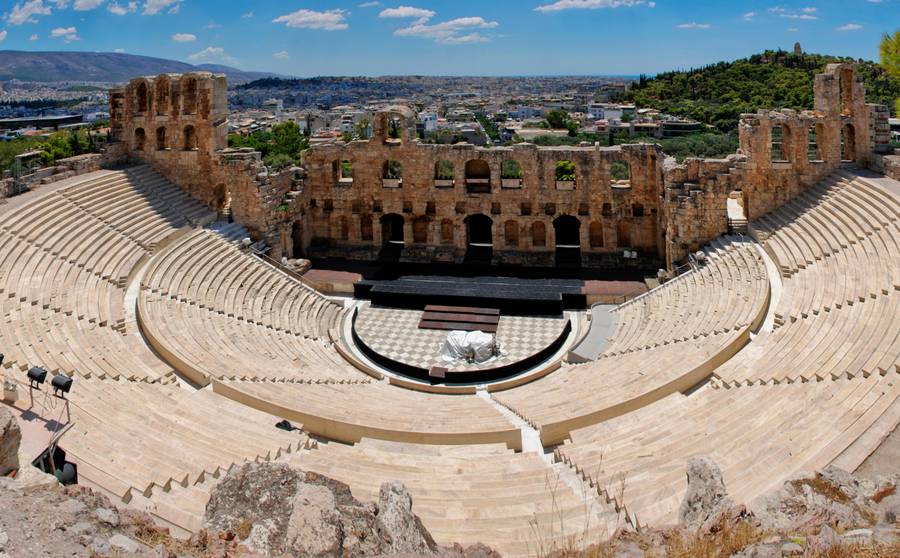Discovering the Timeless Allure of the Odeon of Herodes Atticus

Nestled at the foot of the Acropolis, the Odeon of Herodes Atticus, or "Herodion" as it's affectionately known, stands as a testament to Athens' rich cultural and architectural heritage. For guests of the Acropolis View Hotel, this ancient theatre isn't just a landmark; it's a window into the past, offering a direct view to an era that shaped Western civilization.
Architectural Splendor
Constructed in 161 AD by Herodes Atticus, a wealthy Roman philosopher and teacher, the Odeon originally served as a venue for music concerts with a capacity of 5,000. It showcases the classic elements of Roman theatre architecture, with a semi-circular orchestra and a two-story façade made of marble. Unlike Greek theatres that were typically built into hillsides, the Odeon features a Roman innovation – a stone structure for the audience seating area, called the "cavea."
The theatre's architectural ingenuity lies in its acoustics. The semi-circular design and the materials used in construction create a natural amplification of sound, allowing even those in the furthest seats to hear clearly. The Odeon's design has withstood the test of time, serving as an inspiration for modern theatre architecture.
A Symbol of Ancient Elegance
Beyond its architectural marvel, the Odeon of Herodes Atticus symbolizes the fusion of Greek and Roman cultures, evident in its design and purpose. In its ancient years, it hosted performances that were a vital part of Athenian life, reflecting the city's status as a cultural hub in the Roman Empire.
The theatre's name itself carries a story of love and remembrance. Herodes Atticus built it in memory of his wife, Regilla. This romantic origin adds a layer of emotional depth to the stone and marble structure, making it not just an architectural marvel but also a monument to eternal love.
From Ancient Times to the Modern Era
The Odeon's journey through history is as dramatic as the performances it once hosted. After its initial period of glory, it fell into disuse and was partially destroyed. It wasn't until the 1950s that the theatre underwent a significant restoration, rekindling its ancient splendor.
Today, the Odeon of Herodes Atticus is more than just a relic. It's a living, breathing part of Athens' cultural scene, hosting a variety of performances, including concerts, operas, and classical tragedies. This seamless blend of ancient structure and contemporary art makes the Herodion a unique venue, where history and modernity coexist.
A Stage for Legendary Performances
Among the many events held at the Odeon, one stands out for its historical significance: the performance of Maria Callas in 1957. This concert is often hailed as the most famous event ever held at the theatre, marking a turning point in its modern use. Callas, with her extraordinary talent, breathed new life into the ancient stones, connecting the past with the present in a night of unforgettable music.
The View from Acropolis View Hotel
For guests at the Acropolis View Hotel, the proximity to the Odeon offers a unique opportunity. Imagine waking up to a view of the sun rising over the Herodion, its marble columns glowing in the morning light. Or picture a relaxing evening on the terrace, with the Acropolis and the ancient theatre as your backdrop. This experience connects you to the heart of Athens, not just as a spectator but as a part of its ongoing story.
In Conclusion
The Odeon of Herodes Atticus is more than just an ancient theatre; it's a symbol of Athens' enduring legacy. Its architectural brilliance, historical significance, and ongoing cultural contributions make it a must-visit for anyone traveling to the city. And for those staying at the Acropolis View Hotel, it's an experience that's just a glance away – a blend of history, art, and beauty that epitomizes the spirit of Athens.
